Gujiya recipe aka mawa gujiya is an authentic Indian sweet recipe which has been prepared for ages in northern Indian houses during festivals like Holi and Diwali. This super delectable piece of delight is perfect for spreading sweetness, warmth, comfort and joy during the festive season. It is basically a crescent shaped deep-fried filled pastry and the filling is prepared with mawa aka milk solids, ghee, sugar, dry fruits and a pinch of cardamom powder. There is no fixed time to have this delight. People can grab it from the container and devour it whenever they feel hungry.
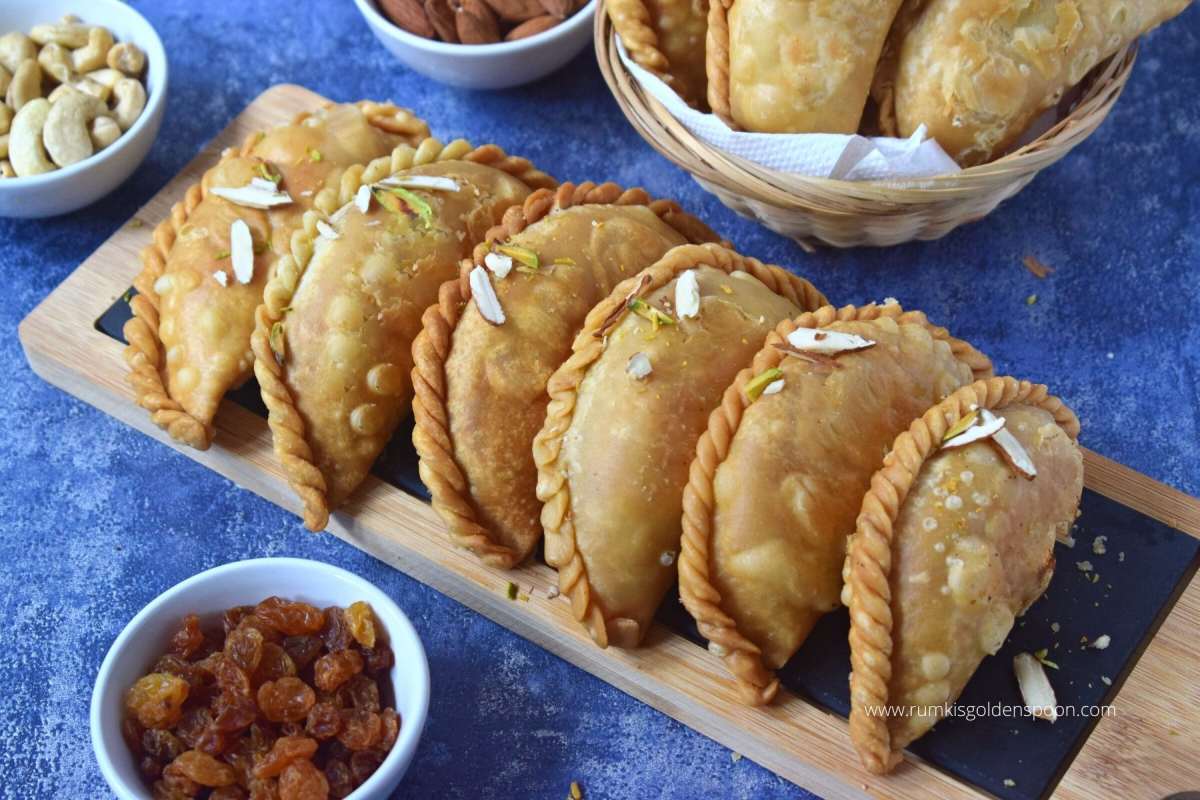
Table of Contents
About the recipe
Tips and Suggestions
Frequently Asked Questions
How to make Gujiya with khoya (step wise photos)
Recipe Card
What is gujiya?
Gujiya is a traditional Indian sweet recipe which is prepared in many Indian houses during the time of Holi and Diwali. It is a crescent aka half moon shaped deep fried crispy-flaky pastry stuffed with sweet mawa (milk solids) and dry fruits filling inside with a hint of cardamom.
Variation in gujiya
There are various ways to prepare gujiya recipe. Every region has their own way to prepare this recipe using different fillings and they are all known by different names. But the size, shape or methods of preparing dough and frying are almost the same.
- In Maharashtra, it is known as Karanji prepared with the stuffing of coconut, milk and poppy seeds.
- In Gujarat, it is known as Ghughra prepared with the stuffing of semolina, dry coconut and dry fruits.
- In Bihar, it is known as Purukiya prepared with the stuffing of semolina, mawa and dry fruits.
- In Goa, it is known as Nevris prepared with the stuffing of coconut and jaggery
- In Andhra Pradesh, it is known as Kajjikayalu prepared with the stuffing of semolina, dry coconut.
- In Rajasthan, there is another variety of gujiya prepared where after frying the gujiya, it is dipped in sugar syrup. Then chopped nuts are sprinkled over them.
For any Indian, the festive season is very special when joy is in the air. People spread only positivity, happiness and laughter. The bonding between families, relatives and friends gets stronger. Mawa gujiya is an inimitable part of Indian culture to cherish those special moments during that festive occasion.
Though nowadays gujiya recipe is readily available in sweet shops or as packaged food in supermarkets, but I still prefer homemade gujiya over the market bought ones. It contains the love, effort, skills and emotions of homemakers which always makes it more special than any market bought ones. It not only tastes better but is also much healthier than readymade ones. Though a small effort would be required to prepare it at home, but you can easily see the difference after making it at home. It is crispy and flaky in texture with irresistible taste and flavor.
Recipe for gujiya is simple and easy to make but it requires both time and patience at the same time to be prepared. All the ingredients required for the recipe are very common and each ingredient is easily available in any Indian shop. The best part of the recipe is that you can store it in an airtight container in a cool dry place for many days and have it whenever you crave for something sweet.
First time, I had this delight during my college days and one of my north Indian roommates brought a large container full of mawa gujiya from her home after Holi in our hostel. I just loved the gujiya recipe so much that I couldn’t stick to devouring only one piece.
It’s not like that in our home gujiya is not prepared. It is prepared every year during sankranti but the version is different. Gujiya recipe Bengali is different from north Indian style gujiya and it is known as narkeler bhaja puli. In this recipe, sweet coconut filling is used and the texture of the Bengali gujiya is less crispy but flaky. I will definitely share this authentic Bengali gujiya recipe with you soon. But now let’s get back to the holi special mawa gujiya.
I got the gujiya recipe from my friend and tried the recipe. On my first attempt, the taste of the filling was awesome but the texture of the gujiya was not perfect. But on my second attempt, it came out perfect. Till now, I have prepared the mawa gujiya plenty of times and every year, I prepare it either before Holi or Diwali. Now in our home, it’s a must to prepare a large batch of it during these festivals.
Gujiya recipe step by step photos and instructions have been provided in the ‘Instruction’ section of the recipe. If you follow each step of my recipe precisely then you will get perfectly crispy, flaky and delicious gujiya which will taste much better than the market bought ones. I have included all the tips and tricks below to make the recipe easier for you. But before directly jumping into the recipe, let me share a few interesting things about the recipe.
Ingredients for gujiya
All-purpose flour aka maida: It is the primary ingredient which provides body to the gujiya recipe.
Ghee: It is another most important ingredient which is used in three stages of preparing gujiya.
- For moyen
- For preparing the filling
- For deep frying the gujiya
Ghee is added as moyen in maida. In the process of moyen, fat is added to the dough for crispy and flaky texture.
For the filling, ghee is used to fry the dry fruits and mawa.
Other than that many people use Ghee or a combination of oil and ghee to fry the gujiyas.
Salt: It is used to enhance the taste of the dish and to give a balanced taste.
Water: It is used to prepare the dough of all-purpose flour. Always use water at room temperature for the recipe.
Mawa: Mawa is the primary element of gujiya filling. It provides richness, taste and flavour to the dish.
Dry fruits: Chopped nuts are used in the gujiya filling to provide flavor and bite. You can use a choice of your nuts like cashew, pistachio, raisins, almond or walnut for the recipe.
Sugar: It provides sweetness to the dish. I always prefer to use powdered sugar for the recipe.
Cardamom powder: It is added as a flavoring agent and gives better flavor to the dish.
Oil: It is used to deep fry the gujiya till crispy and golden brown.
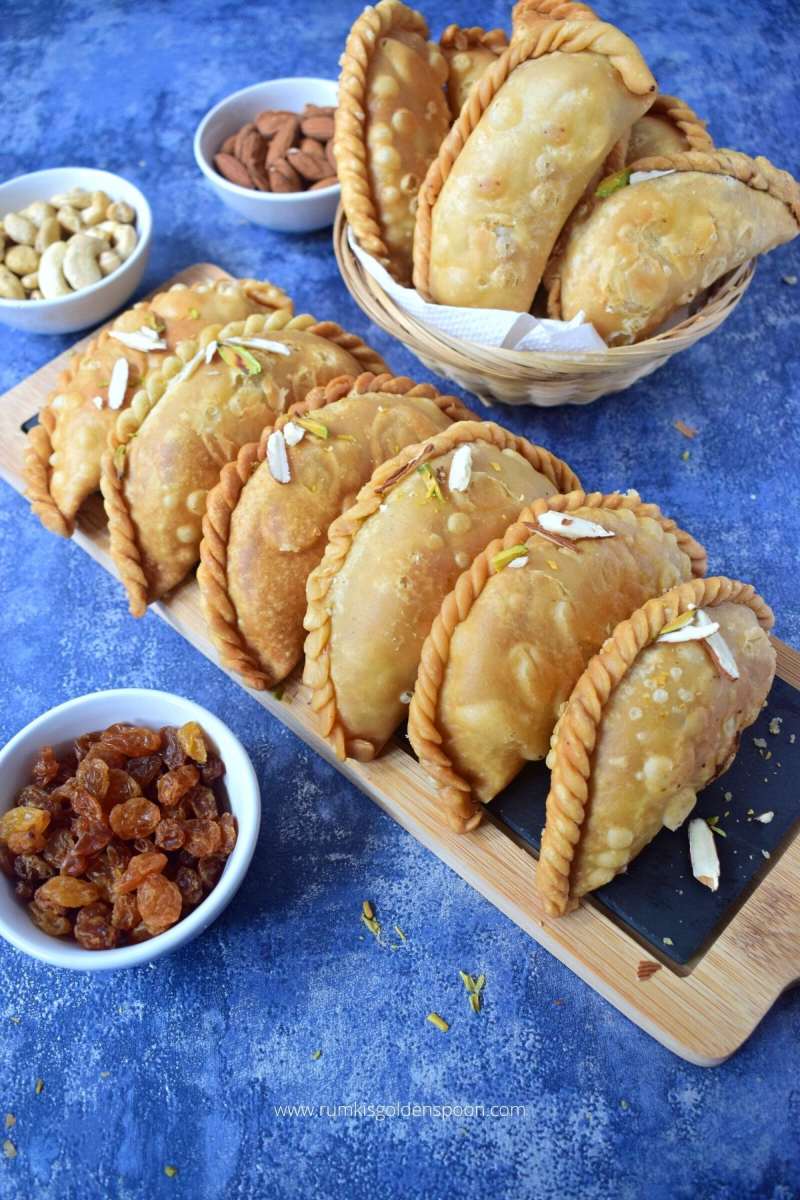
Tips to prepare perfect gujiya
- Traditional gujiya recipe is prepared with all-purpose flour. It gives better texture and taste to the dish.
- It is very important to add moyen (fat added to the flour) properly. It provides perfect flaky texture along with crispiness to the dish.
- You can use ghee aka clarified butter or refined oil for moyen. But I always prefer to use ghee for this because it gives better taste and flavor along with crispier and more flaky texture.
- Addition of a little bit of salt into the dough enhances the taste of the dish.
- Always prepare a tight dough for the perfect texture of gujiya. Addition of too much water makes the dough soft and addition of less water makes the dough stiff and hard.
- After preparing the dough, always cover it with wet cloth and allow it to rest for 30 minutes. It helps to relax the glutens.
- Roll the dough ball to a medium thick circular disc. The thickness should be like a poori. If you roll it too thin, then the flaky texture won’t come to the dish.
- Don’t add too much filling into the gujiya then it can get open during the time of frying.
- Always apply water with your finger tip at the edges before sealing the gujiya. Then it won’t get open at the time of frying.
- You can use a choice of dry fruits like almond, cashew, raisins and pistachios for the filling.
- After frying the mawa, allow it to come to room temperature before adding sugar or else the filling will become liquidy.
- Always use powdered sugar for the filling. If you don’t have powdered sugar then grind the normal sugar in a mixer grinder before adding.
- Don’t skip cardamom powder from the filling. It gives better flavor to the dish.
- Add ghee in oil for deep frying the gujiyas to get the best result. The combination of both gives better flavor and taste to the gujiyas.
- Always fry the gujiyas at low or medium low flame for perfectly even frying.
- Always fry the gujiya only till the color is light golden brown, not more than that.
- After straining the excess oil, transfer them on a tissue lined plate. The kitchen tissue will absorb the excess oil.
- Let them come to room temperature before transferring them into a container or else gujiya will become damp.
Frequently asked Questions
What type of mawa to be used for the filling?
You can use any kind of mawa for the recipe. If you like, you can freshly prepare mawa for the recipe or you can buy it from sweet shops. You can also use frozen mawa which is available in Indian stores.
If you aren’t able to manage either of them then you can prepare instant mawa with milk powder for the gujiya recipe. I have already shared this recipe in my previous post.
How to shape gujiya?
There are various ways to design the edges of gujiya. But traditionally, it is shaped as a crescent and the edges are joined with hand in rope design. If you know the technique then you can go for it.
Other than that, there are few easy ways to shape gujiya. After adding the filling, you can join the edges and design it with a fork.
Nowadays gujiya moulds are easily available in the market. You can use that to shape gujiya.
Why does my gujiya break?
There are various reasons for which your gujiya can break.
- First of all, if the moyen of your gujiya dough is not perfect then it can break.
- If you overcrowd the pan during the time of frying gujiya and are not able to handle it delicately then it can break.
- If you flip the gujiyas frequently during the time of frying then it can also break.
Why does my gujiya get open during the time of frying?
It mostly happens because of two reasons.
- If the edges of gujiya are not sealed properly.
- If too much stuffing is added.
Why does my gujiya become soft and soggy?
If you take care of a few things then your gujiya will definitely be crispy.
- For crispy gujiya, try to add ghee aka clarified butter for moyen.
- The moyen has to be perfect for the dough. If you add less oil or ghee then your gujiya will become soft.
- The filling has to be at room temperature and dry. If you use hot or wet filling then your gujiya will turn soft or soggy.
- Last but not the least, gujiya should be fried at low or medium low flame. If you fry them over high flame then the gujiya will become brown from outside and won’t get cooked from inside. As a result you will get soft and soggy gujiya.
How to fry gujiya?
Gujiya should be fried at low or medium low flame. If you fry them over high flame then the gujiya will become brown from outside and won’t get cooked from inside. One gujiya batch takes almost 10-15 minutes to get fried evenly and perfectly.
Can I bake gujiya?
Yes, of course. You can bake gujiya too other than deep frying. After shaping the gujiya, brush oil or melted ghee on them and place them in the preheated oven for 20-30 minutes at 200°C/ 180°C Fan/ Gas 6. The baking time may vary. Please keep an eye on it.
Can I store gujiya?
After frying the gujiya, allow it to come to room temperature. Then store them in an airtight container and keep it in a cool dry place away from sunlight. In this way you can store the gujiya for a week.
How to make gujiya with khoya?
There are four parts of preparing gujiya with khoya.
- Preparing the stuffing
- Preparing the dough
- Shaping the gujiya
- Frying the gujiya
Making stuffing
First chop the nuts and keep them aside. Crumble the mawa before frying. Then take a pan and ghee into it. Once the ghee melts completely, add the chopped nuts and fry them in low flame until you get the aroma of roasted nuts. Then add the mawa into the pan and fry it evenly in medium to medium low flame for 4-5 minutes. Stir it continuously until it starts melting. If you are using dry mawa or frozen mawa then you can add 2-3 tablespoons of milk to make the mawa soft. Once the mawa comes to a mass shape, transfer it to a bowl and allow it to cool down completely.
Then add raisins, cardamom powder and powdered sugar, one by one into the room temperature mawa and mix it evenly. Now your stuffing is ready. Keep it aside.
Making dough
You can prepare the dough while the mawa is resting to cool down as mentioned in the above step to reduce the preparation time. For the dough, take a large mixing bowl and add all purpose flour aka maida into it. Add ¼ teaspoon salt into the bowl. Then add melted ghee aka clarified butter(at room temperature) into it and mix it evenly with the help of fingers. The flour should get binded when you take it in your fist and apply pressure. The moyan (fat added into the flour)of the dough is very important to get the perfect texture of gujiya.
Then add water slowly at a time and prepare tight dough. Don’t over knead the dough or else it will release gluten and you won’t get the perfect texture of gujiya. Cover the dough completely with either wet cloth or cling film and allow it to rest for half an hour.
Shaping gujiya
After half an hour, uncover the dough and knead it once again and make it smooth. Divide them in 15 equal portions to prepare small flat dough balls. Cover the rest of the dough balls while working on one. Place the dough ball on a rolling board and roll it with a rolling pin to a round shape of 4-5 inches diameter. The thickness should be medium like poori. It neither be too thick nor be too thin.
Now apply water at the edges of the rolled out dough. Add 1 to 1½ tablespoons stuffing on one side and keep the edges empty. Don’t add too much stuffing or else it will be difficult to seal the gujiya.
Now carefully fold and join the edges with your fingers. Gently press the edges and seal the gujiya properly so that the stuffing cannot come out. At this moment, you can design the gujiya according to your preferred choice.
- You can trim the edges with the help of a pizza cutter.
- If you have gujiya mould then you can use it to make designs.
- With the help of a fork, you can make a design around the edges and seal it perfectly.
- The traditional way is by using hand. Just keep on twisting the edges and fold till the end. In this way, gujiya looks best and is sealed perfectly too.
After shaping all the gujiyas, cover them with wet cloth before frying.
Frying gujiya
Put a pan on flame and add ghee or oil to deep fry the gujiya. Ghee (Clarified Butter) gives a nice aroma to the dessert. But many people prefer healthy oil over ghee. But I suggest adding some ghee in the oil for frying the mawa gujiya. It gives a nice flavor to it. I have added 1 heaped tablespoon of ghee in oil. Put the flame in medium and wait until the oil is ready.
The oil has to be medium hot and not smoking hot. Now put the flame on low and add the shaped gujiya slowly into the oil. Gujiya should be fried at low or medium low flame till light golden brown. Flip the gujiyas in between and fry them evenly. One gujiya batch takes almost 10-15 minutes to get fried evenly and perfectly. So be patient at this stage. If you fry them over high flame then the gujiya will become brown from outside and won’t get cooked from inside. Strain the mawa gujiya with a slotted spoon and remove the excess oil. Place them carefully on a tissue lined plate.
Now your gujiya recipe is ready to serve. Serve it warm or at room temperature. After cooling down, store them in a dry airtight container.
Many holi recipes have already been shared in my previous posts. You can check few of them like
Instant jalebi
Kalakand
Instant gulab jamun
Baked mathri
Dahi vada
..And Many more…
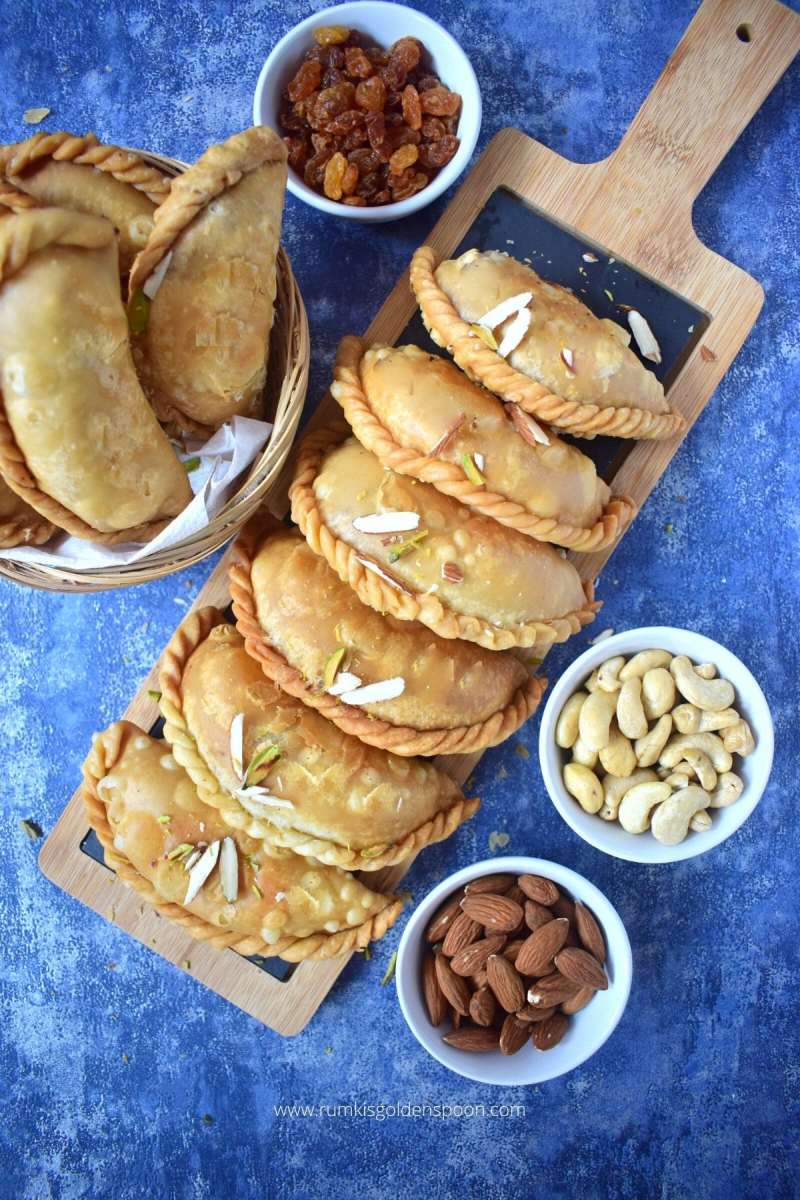
Ingredients:
1 cup = 250 ml
For gujiya dough
- 2 cups all-purpose Flour aka Maida
- 3 tablespoons melted Ghee aka clarified Butter, at room temperature
- ¼ teaspoon Salt
- 1/2 cup Water, at room temperature
For the filling
- 2 cups Mawa aka milk solids
- 1 tablespoon Ghee aka clarified Butter
- 6-8 tablespoons powdered Sugar, adjust according to your taste
- ½ teaspoon Cardamom powder
- 10 Cashew nuts
- 10 Almonds
- 12-15 Pistachios
- 1 tablespoon Raisins
Other ingredients
- 1 tablespoon Water to seal the gujiya, during the time of shaping
- Oil as required, to deep fry the gujiya
- 1 tablespoon Ghee aka clarified Butter, to deep fry the gujiya
Instructions:
- First chop 10 cashew nuts, 10 almonds, 12-15 pistachios and keep them aside.
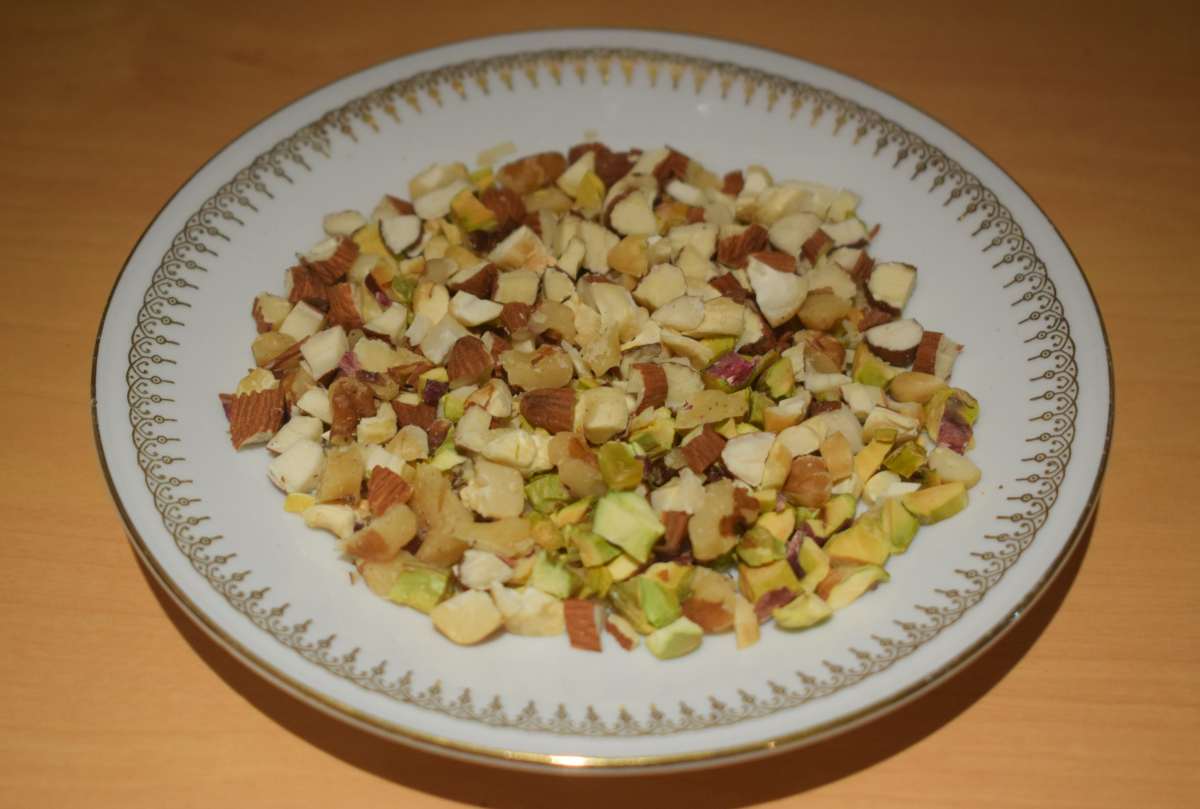
- Crumble 1 cup mawa before frying.
- Take a pan and 1 tablespoon of ghee into it.
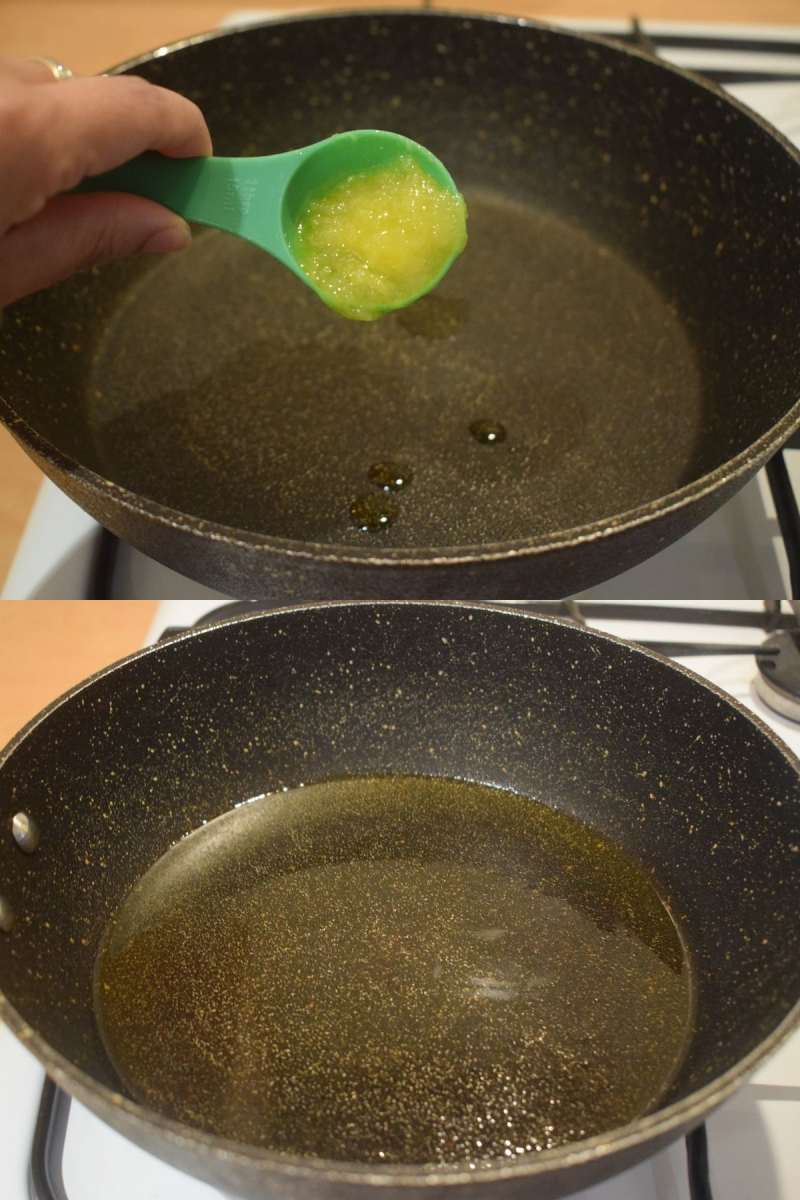
- Once the ghee melts completely, add the chopped nuts and fry them in low flame until you get the aroma of roasted nuts.
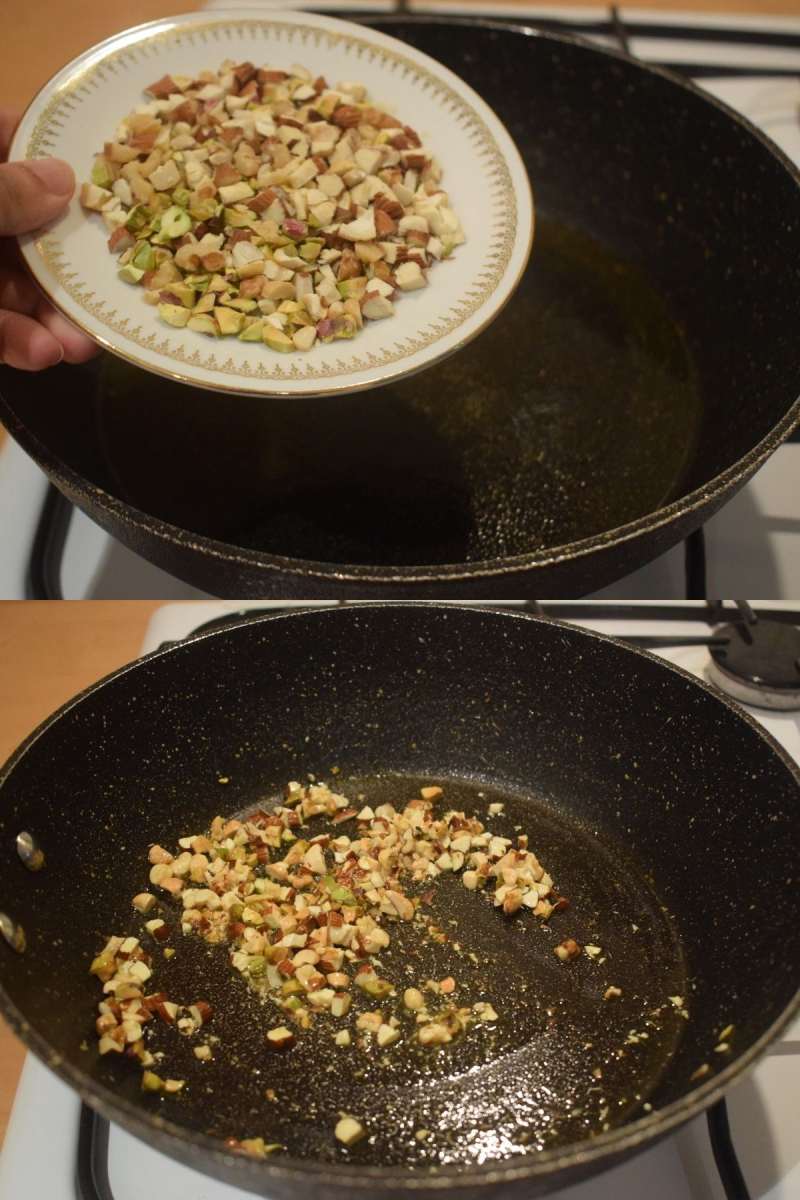
- Add the mawa into the pan and fry it evenly in medium to medium low flame for 4-5 minutes. Stir it continuously until it starts melting.
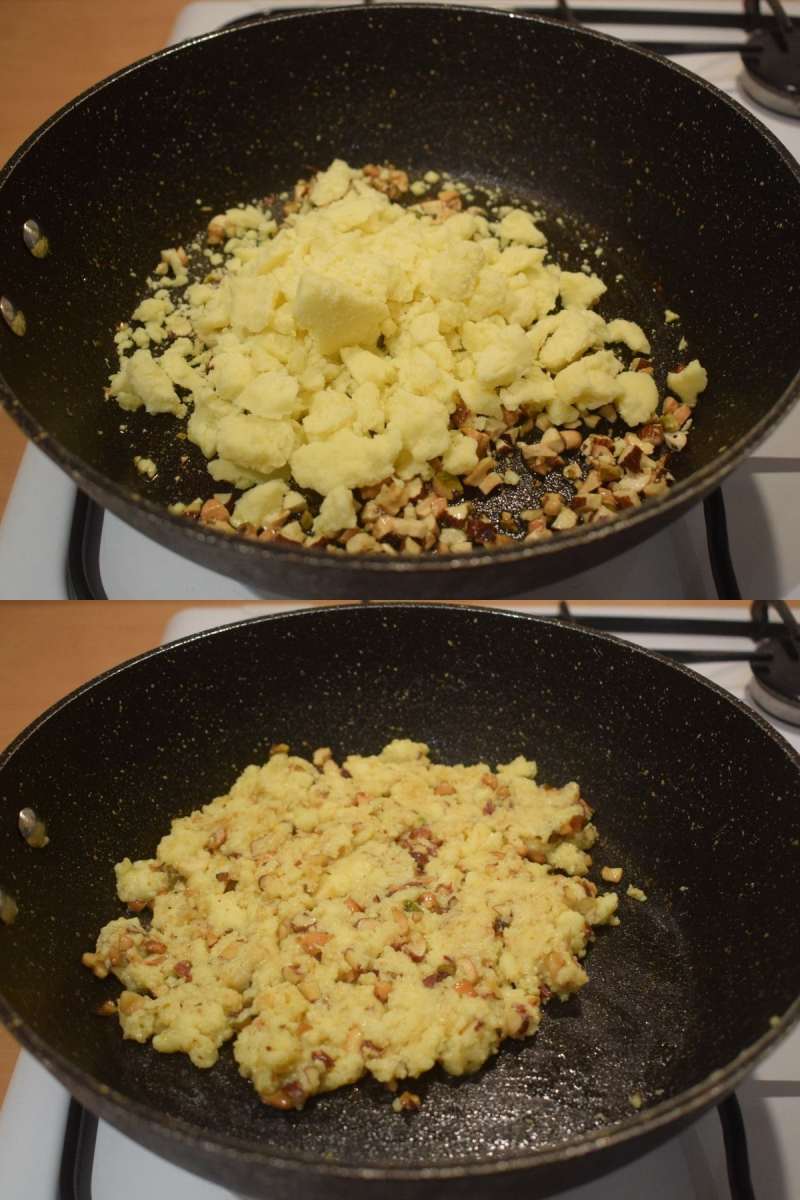
Note: If you are using dry mawa or frozen mawa then you can add 2-3 tablespoons of milk to make the mawa soft. - Once the mawa comes to a mass shape, transfer it to a bowl and allow it to cool down completely.
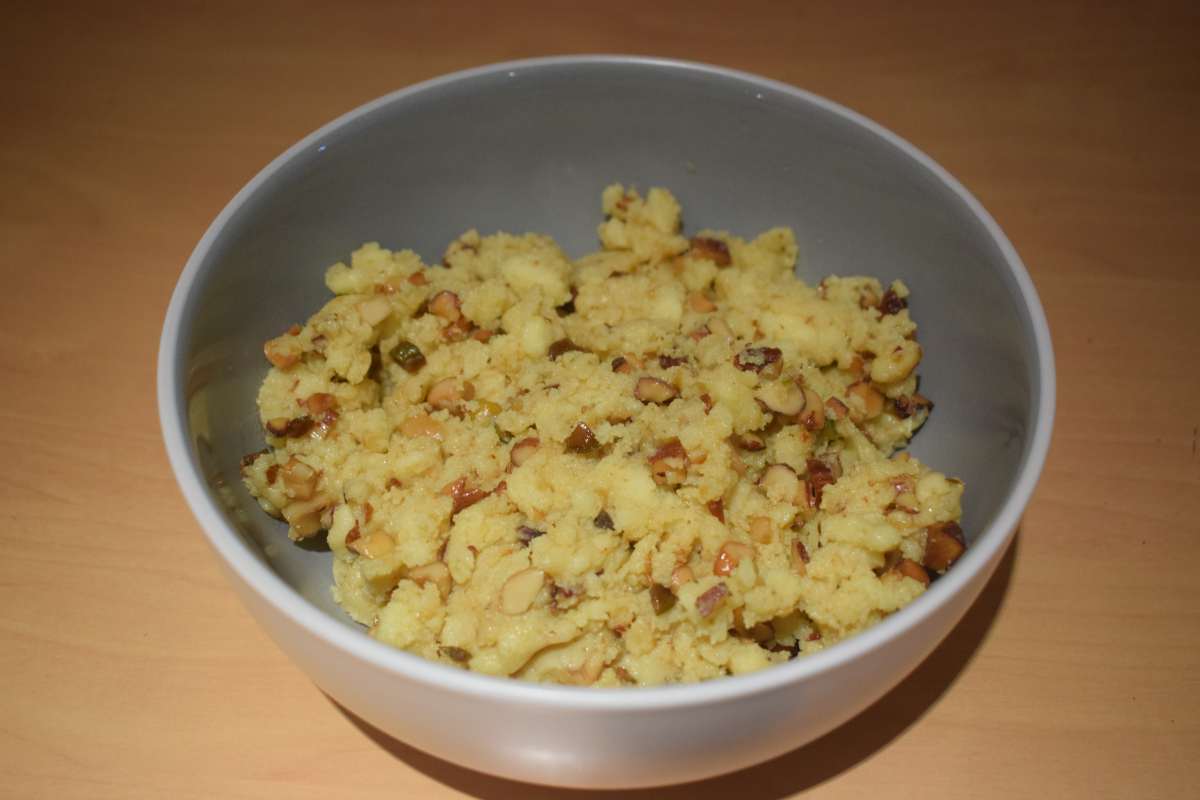
- Add raisins, ½ teaspoon cardamom powder and 6-8 tablespoons powdered sugar, one by one into the room temperature mawa and mix it evenly. Now your stuffing is ready. Keep it aside.
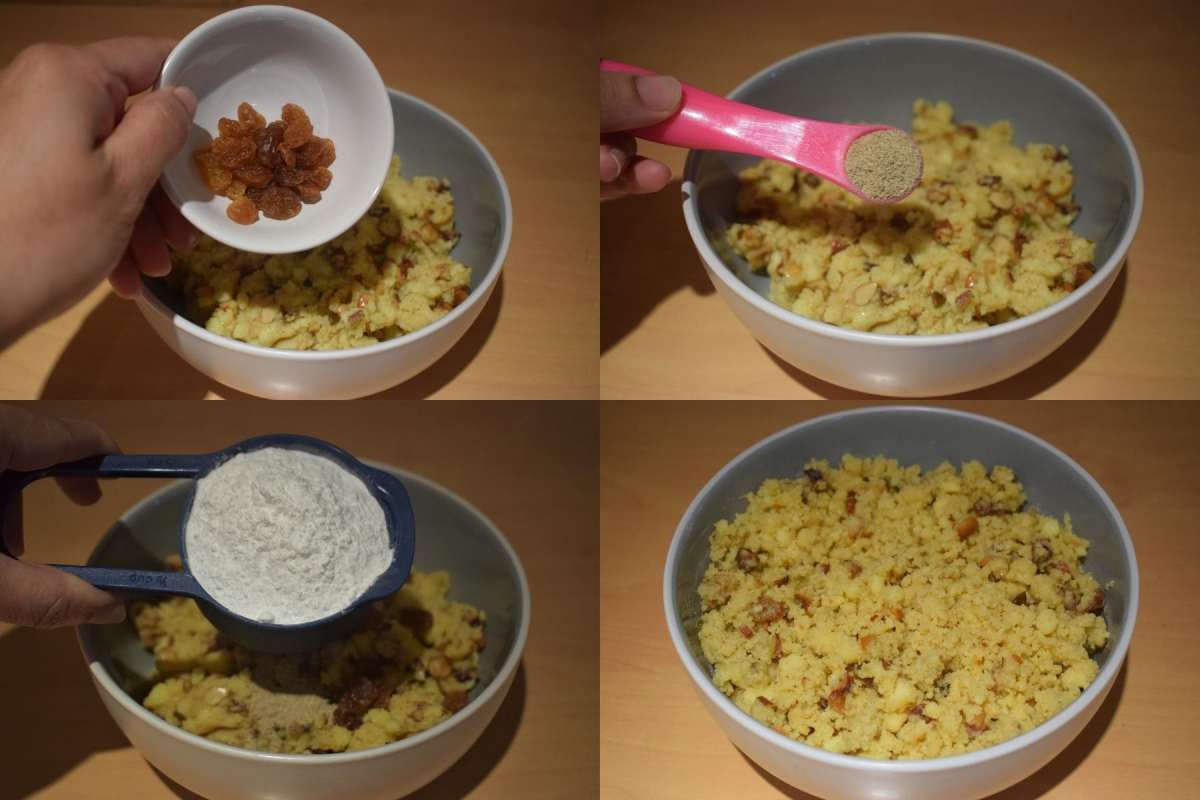
- For the dough, take a large mixing bowl and add 2 cups of all purpose flour aka maida into it. Then add ¼ teaspoon salt into the bowl.
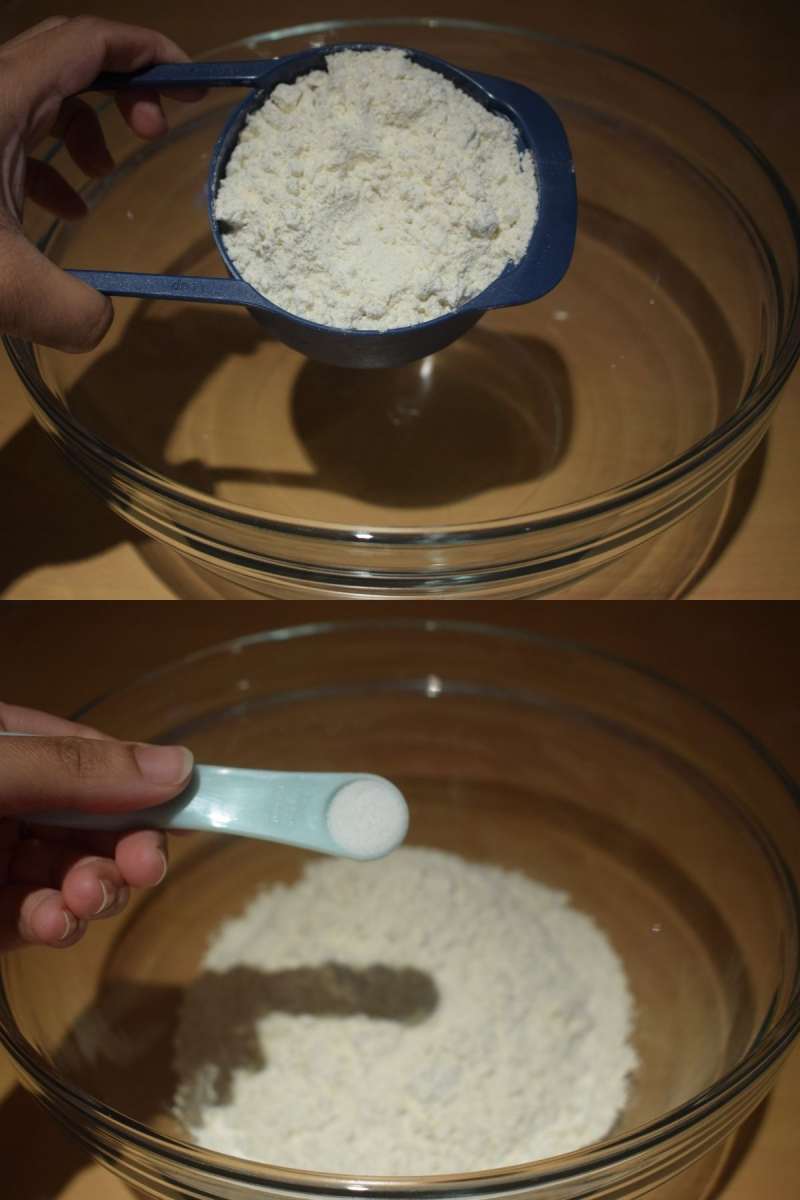
Note: You can prepare the dough while the mawa is resting to cool down as mentioned in the above step to reduce the preparation time. - Add 3 tablespoons melted ghee aka clarified butter at room temperature into it and mix it evenly with the help of fingers. The flour should get binded when you take it in your fist and apply pressure. The moyan (fat added into the flour)of the dough is very important to get the perfect texture of gujiya.
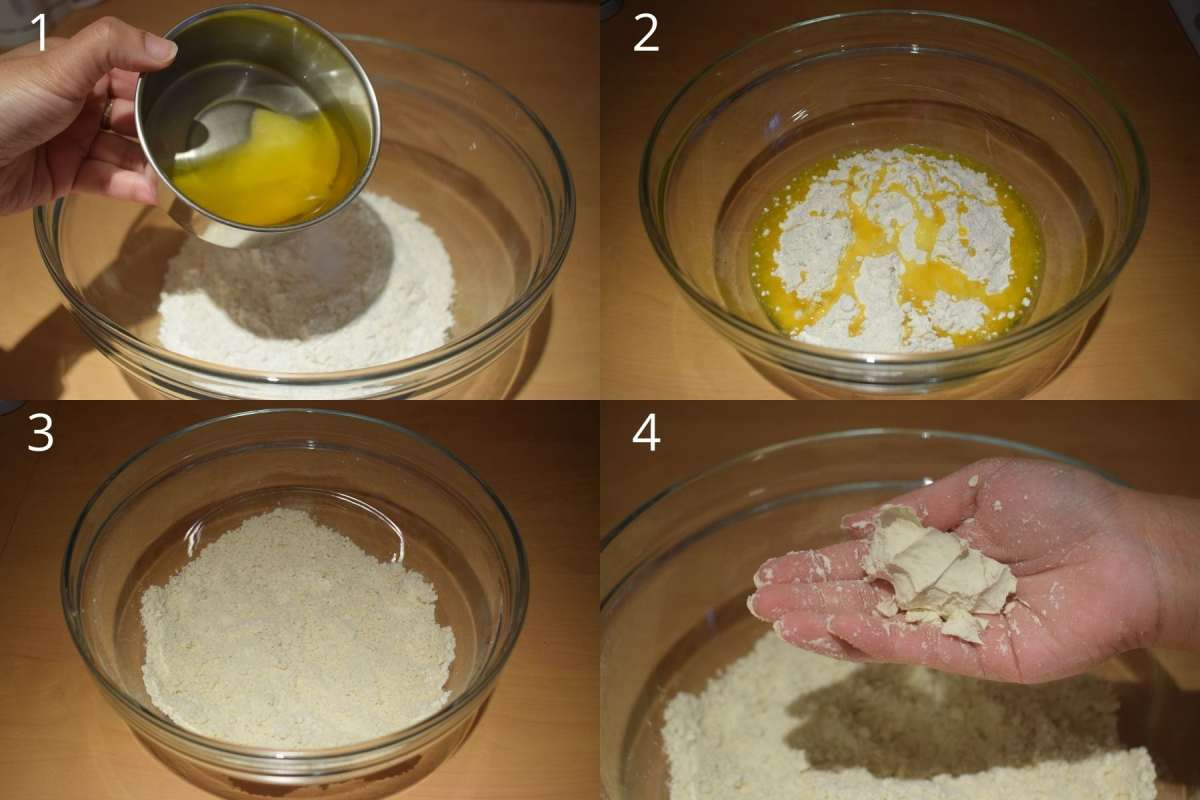
- Add water slowly at a time and prepare tight dough. Don’t over knead the dough or else it will release gluten and you won’t get the perfect texture of gujiya. I have used 1/2 cup of water for preparing the dough.
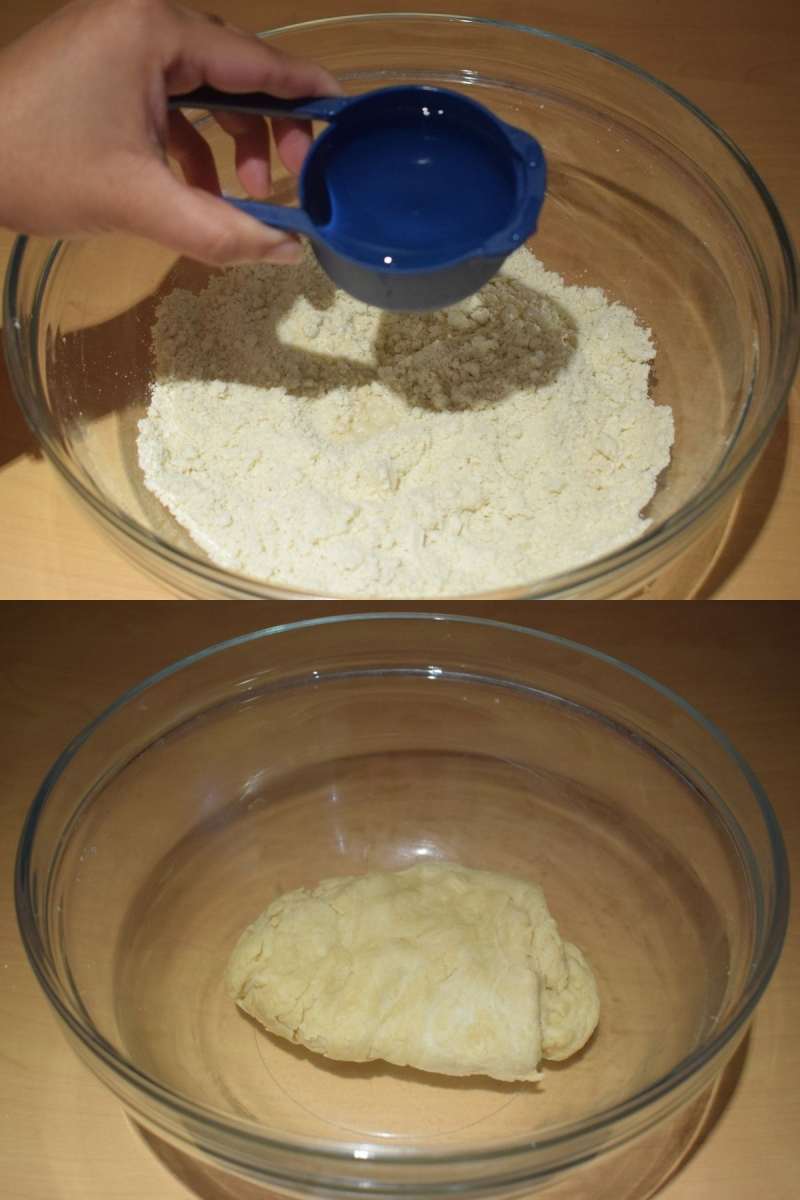
- Cover the dough completely with either wet cloth or cling film and allow it to rest for half an hour.
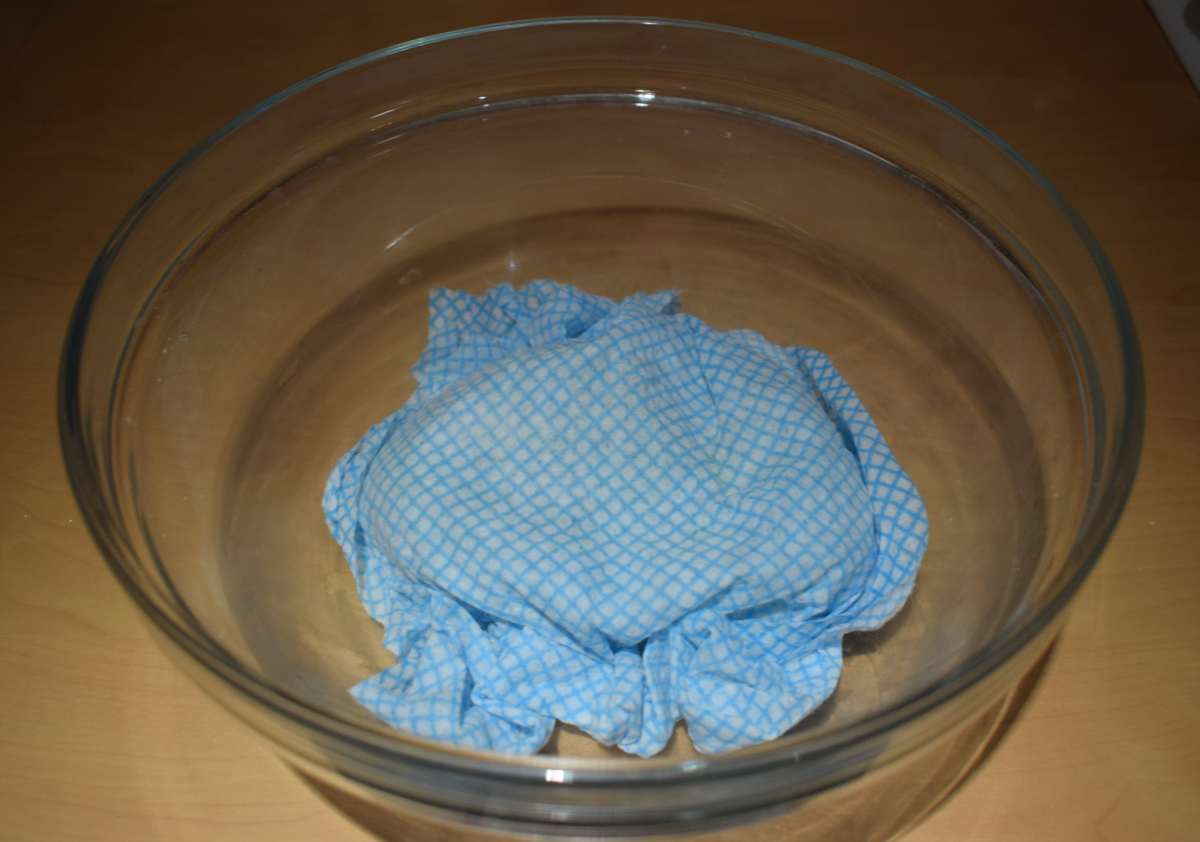
- After half an hour, uncover the dough and knead it once again and make it smooth.
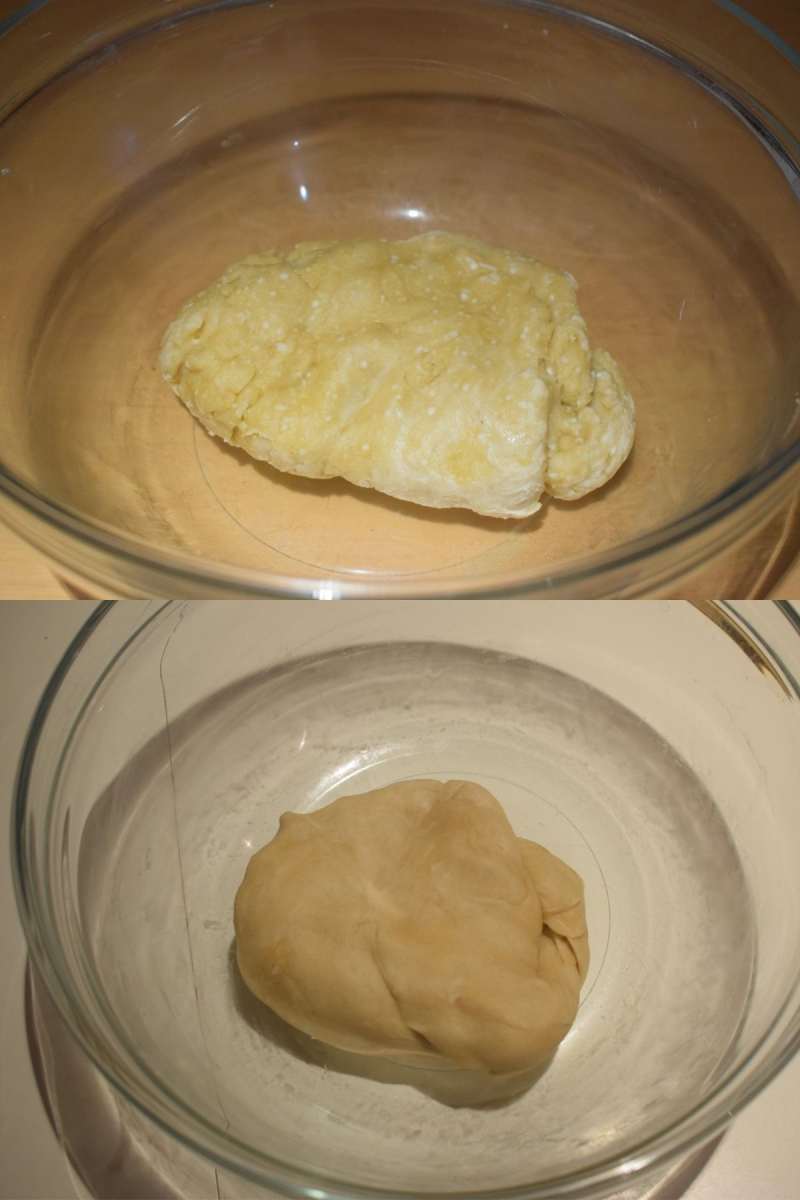
- Divide them in 15 equal portions to prepare small flat dough balls with the help of hands. Cover the rest of the dough balls while working on one.
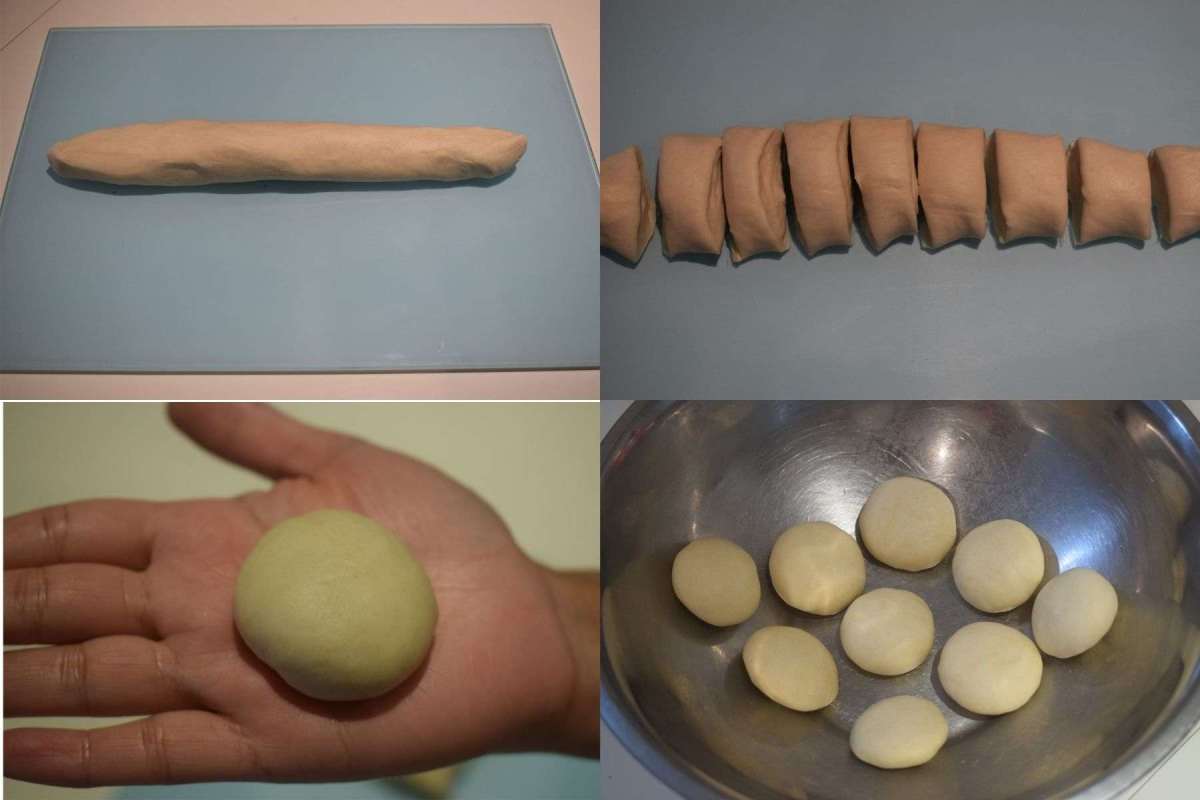
- Place the dough ball on a rolling board and roll it with a rolling pin to a round shape of 4-5 inches diameter. The thickness should be medium like poori. It should neither be too thick nor be too thin.
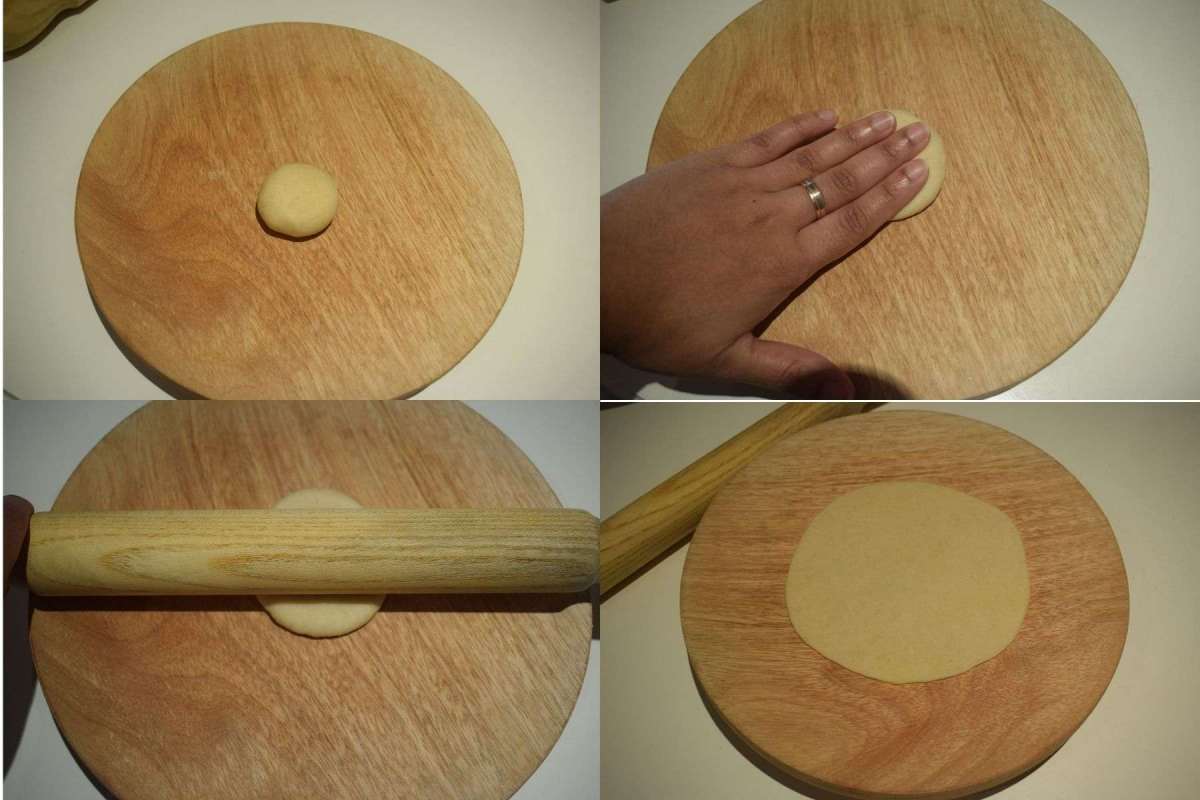
- Take a bowl of water during the time of shaping gujiya. Now apply water at the edges of the rolled out dough with your figure tip.
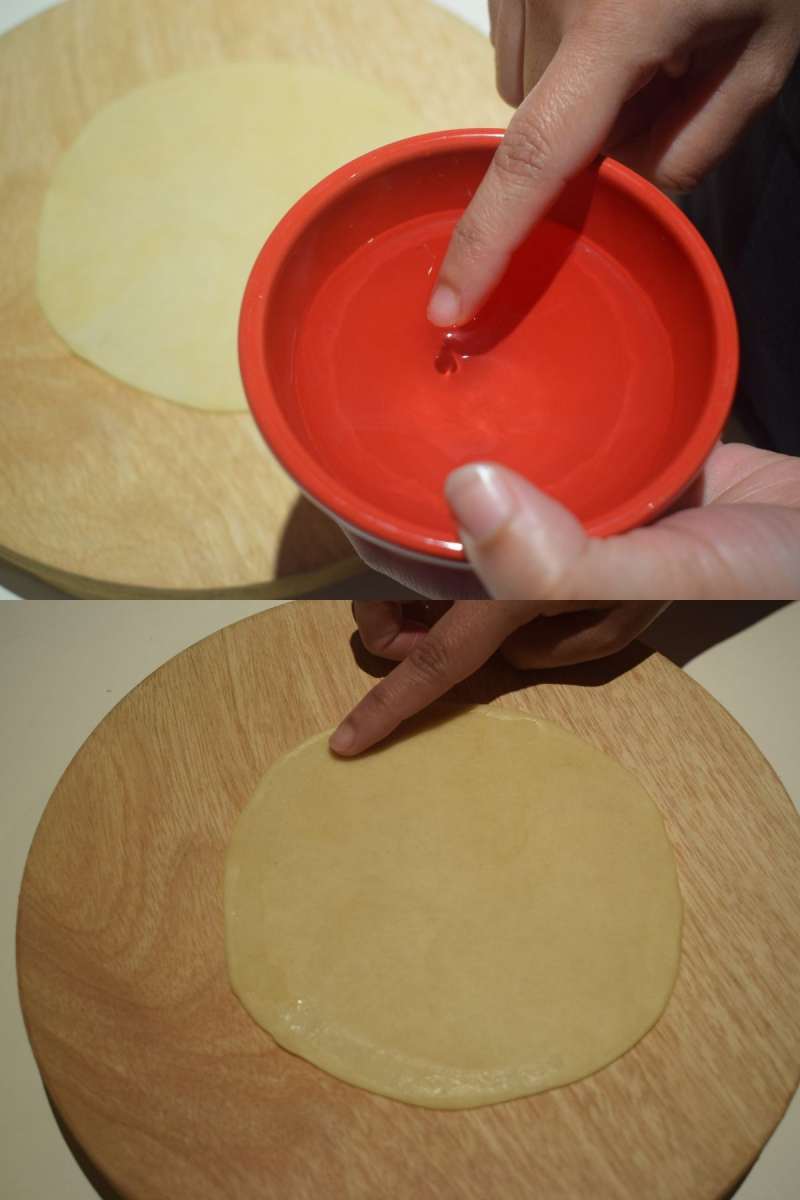
- Add 1 to 1½ tablespoons stuffing on one side and keep the edges empty. Don’t add too much stuffing or else it will be difficult to seal the gujiya.
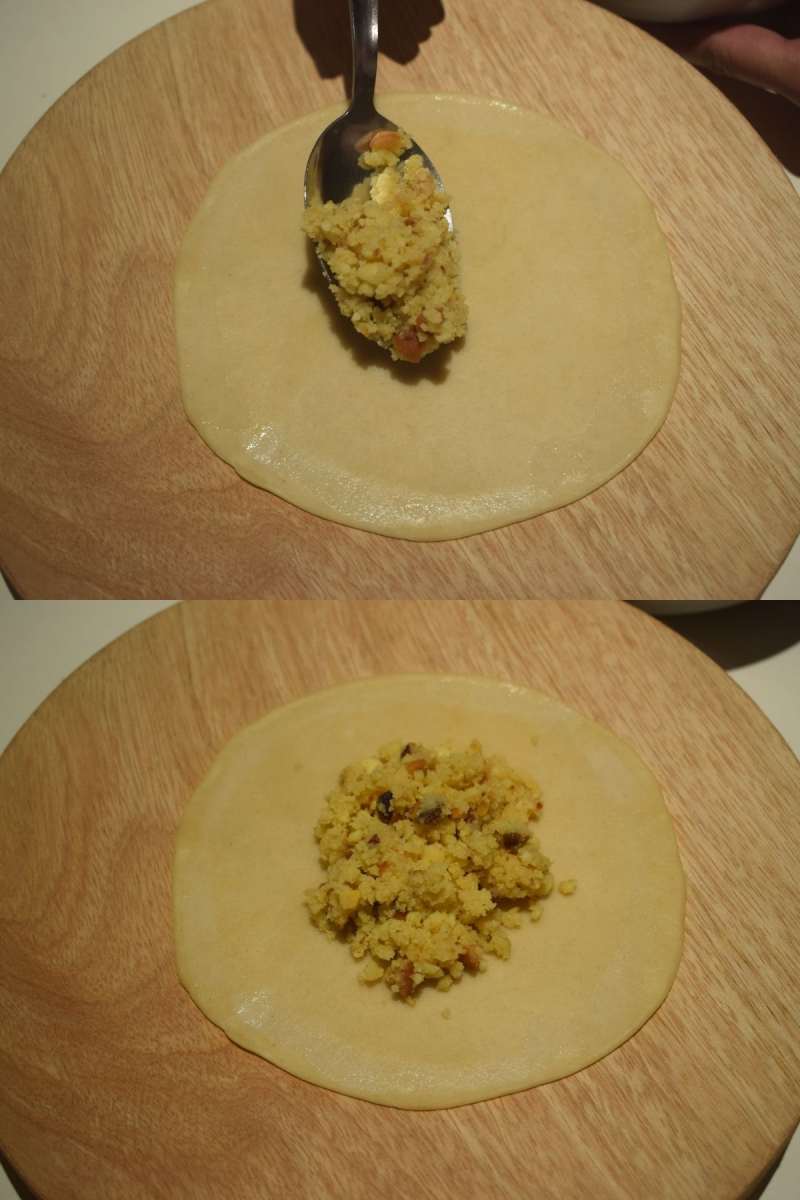
- Now carefully fold and join the edges with your fingers. Gently press the edges and seal the gujiya properly so that the stuffing cannot come out. At this moment, you can design the gujiya according to your preferred choice.
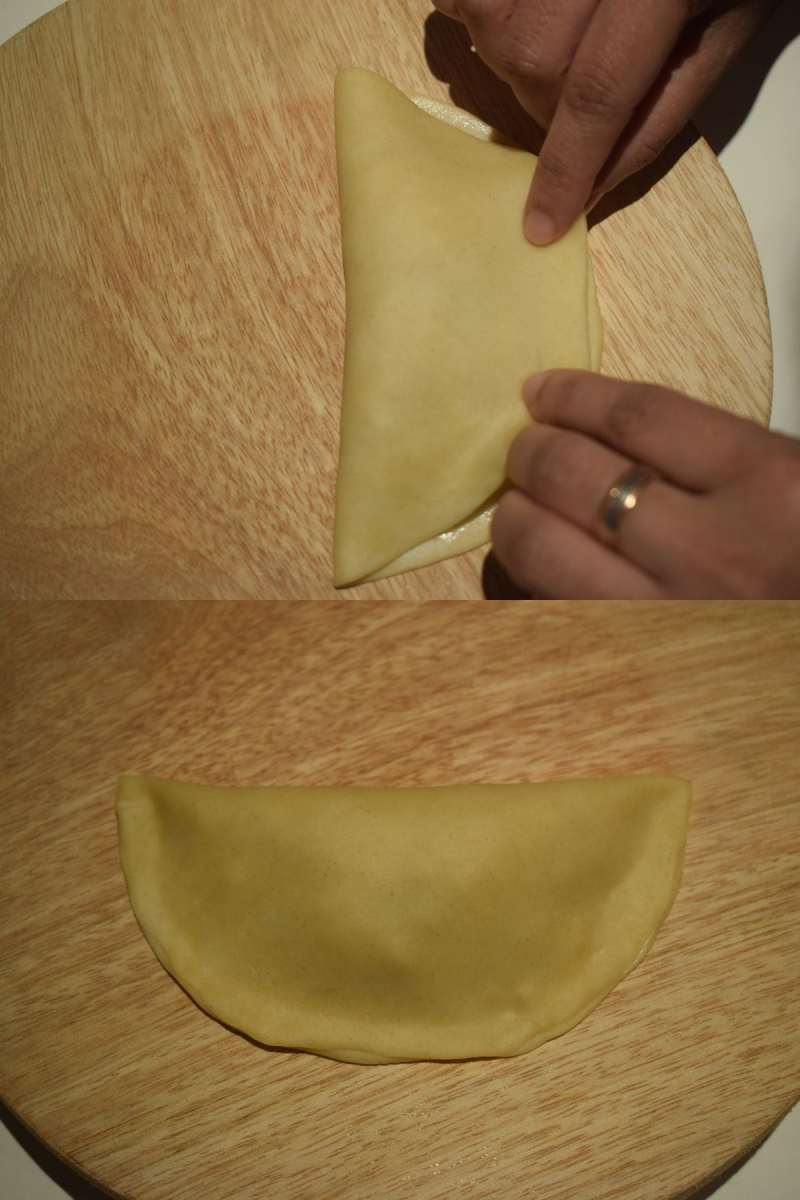
- With the help of a fork, you can make a design around the edges and seal it perfectly. If you have gujiya mould then you can use it to make designs.
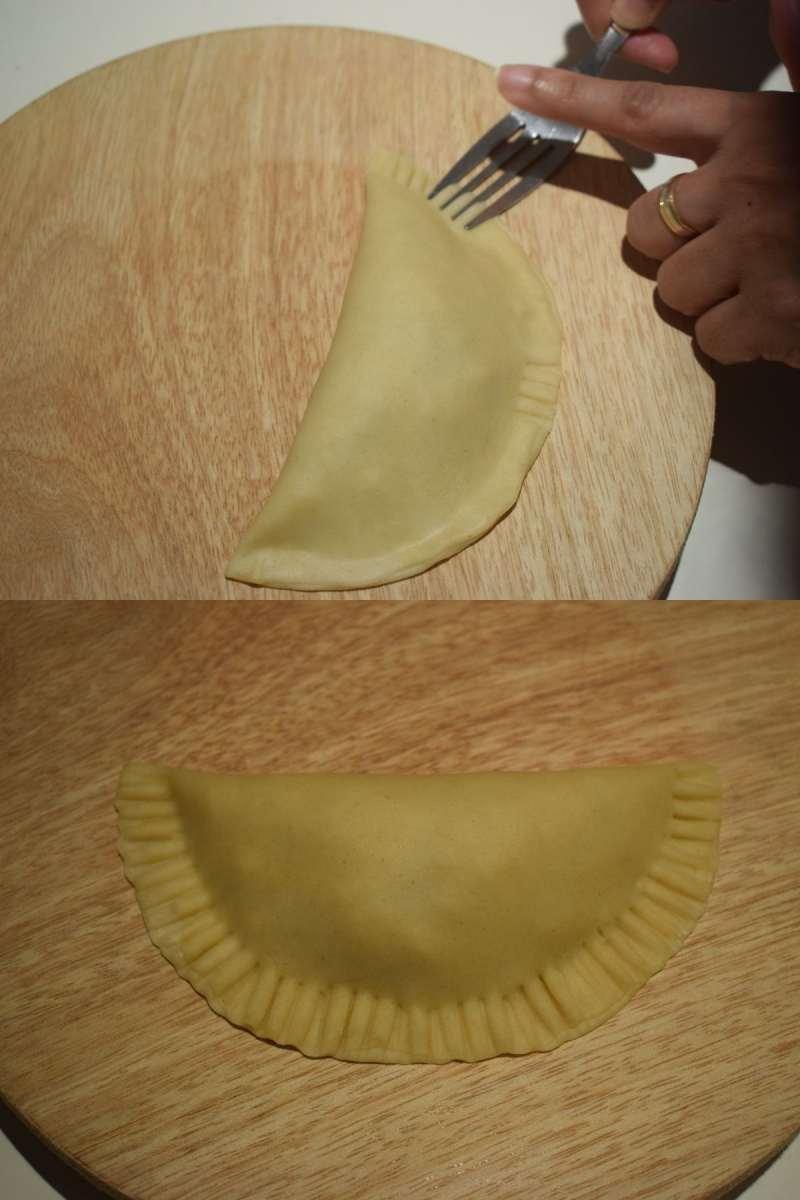
- The traditional way is by using hand. Just keep on twisting the edges and fold till the end. In this way, gujiya looks best and is sealed perfectly too. After shaping all the gujiyas, cover them with wet cloth before frying.
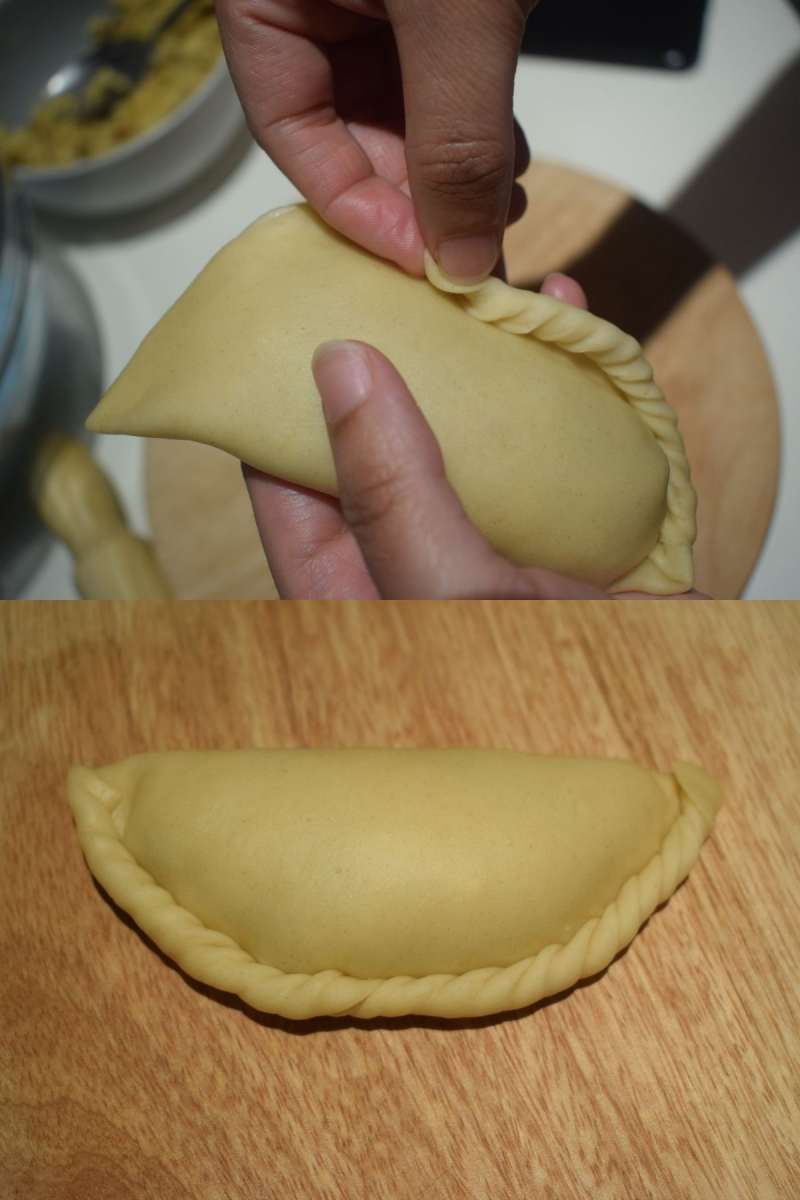
- Put a pan on flame and let it become completely dry.
- Add enough oil to deep fry the gujiya properly. I have added 1 heaped tablespoon ghee in oil for better taste and flavor. Put the flame in medium and wait until the oil is ready. The oil has to be medium hot and not smoking hot.
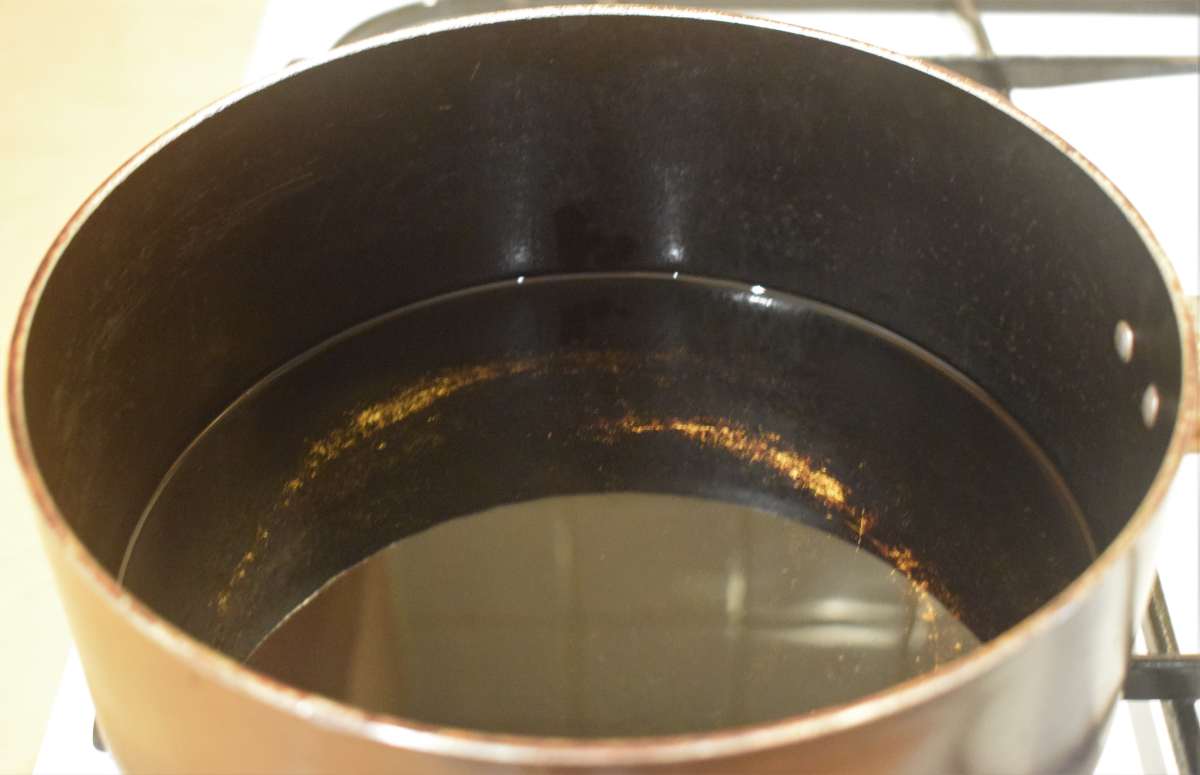
- Now turn the flame low and add the shaped gujiya slowly into the oil. Gujiya should be fried at low or medium low flame till light golden brown. Flip the gujiyas in between and fry them evenly. One gujiya batch takes almost 10-15 minutes to get fried evenly and perfectly. So be patient at this stage.
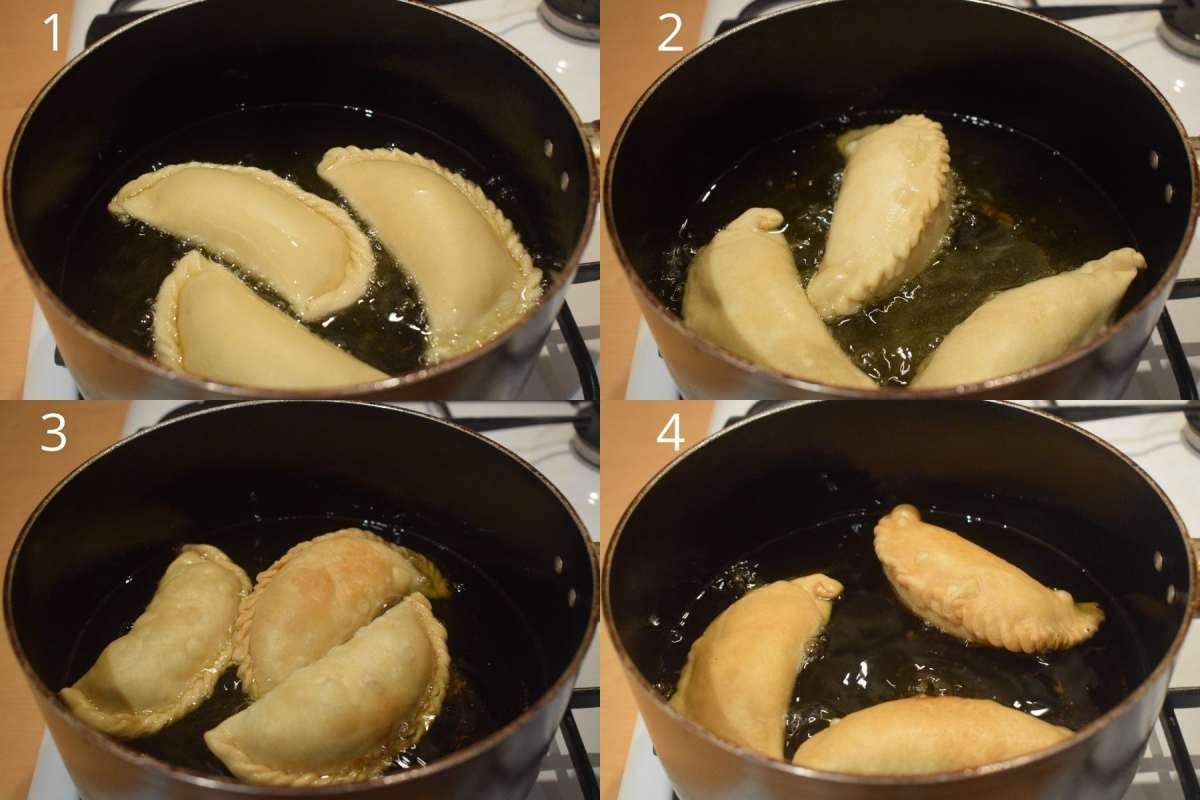
Note: If you fry them over high flame then the gujiya will become brown from outside and won’t get cooked from inside. Don’t overcrowd the pan during the time of frying the gujiya. - Strain the mawa gujiya with a slotted spoon and remove the excess oil. Place them carefully on a tissue lined plate.
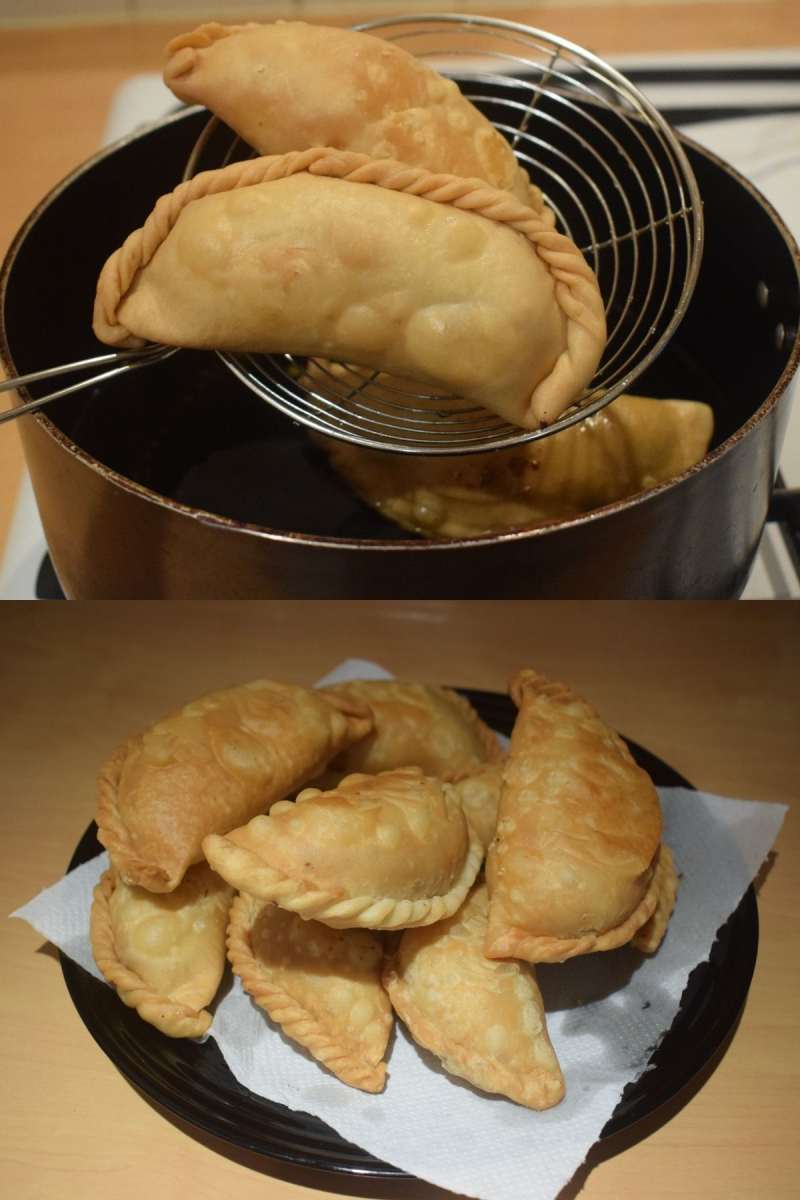
- Now your gujiya recipe is ready to serve. Serve it warm or at room temperature. After cooling down, store them in a dry airtight container.
For the filling
For gujiya dough
Shaping gujiya
Frying gujiya
Serving Instruction
Transfer the mawa gujiya on a serving plate and serve them with a cup of hot tea or have it when hunger calls. Enjoy your homemade Indian sweet recipe with family and friends with a lots gossip during festive days.
How to store gujiya?
After frying the gujiya, allow it to come to room temperature. Then store them in an airtight container and keep it in a cool dry place away from sunlight. In this way, you can store the gujiya for a week.
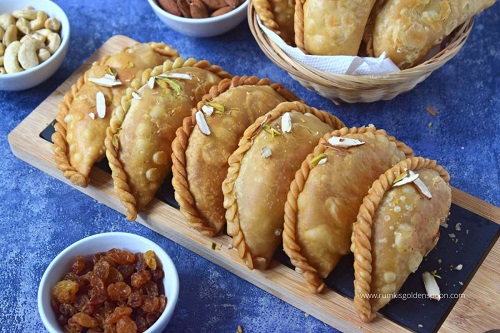
Ingredients
1 cup = 250 ml For gujiya dough
- 2 cups all-purpose Flour aka Maida
- 3 tablespoons melted Ghee aka clarified Butter, at room temperature
- ¼ teaspoon Salt
- 1/2 cup Water, at room temperature
For the filling
- 2 cups Mawa aka milk solids
- 1 tablespoon Ghee aka clarified Butter
- 6-8 tablespoons powdered Sugar, adjust according to your taste
- ½ teaspoon Cardamom powder
- 10 Cashew nuts
- 10 Almonds
- 12-15 Pistachios
- 1 tablespoon Raisins
Other ingredients
- 1 tablespoon Water to seal the gujiya, during the time of shaping
- Oil as required, to deep fry the gujiya
- 1 tablespoon Ghee aka clarified Butter, to deep fry the gujiya
Instructions
For the filling
- First chop 10 cashew nuts, 10 almonds, 12-15 pistachios and keep them aside.
- Crumble 1 cup mawa before frying.
- Take a pan and 1 tablespoon of ghee into it.
- Once the ghee melts completely, add the chopped nuts and fry them in low flame until you get the aroma of roasted nuts.
- Add the mawa into the pan and fry it evenly in medium to medium low flame for 4-5 minutes. Stir it continuously until it starts melting.Note: If you are using dry mawa or frozen mawa then you can add 2-3 tablespoons of milk to make the mawa soft.
- Once the mawa comes to a mass shape, transfer it to a bowl and allow it to cool down completely.
- Add raisins, ½ teaspoon cardamom powder and 6-8 tablespoons powdered sugar, one by one into the room temperature mawa and mix it evenly. Now your stuffing is ready. Keep it aside.
For gujiya dough
- For the dough, take a large mixing bowl and add 2 cups of all purpose flour aka maida into it. Then add ¼ teaspoon salt into the bowl. Note: You can prepare the dough while the mawa is resting to cool down as mentioned in the above step to reduce the preparation time.
- Add 3 tablespoons melted ghee aka clarified butter at room temperature into it and mix it evenly with the help of fingers. The flour should get binded when you take it in your fist and apply pressure. The moyan (fat added into the flour)of the dough is very important to get the perfect texture of gujiya.
- Add water slowly at a time and prepare tight dough. Don’t over knead the dough or else it will release gluten and you won’t get the perfect texture of gujiya. I have used 1/2 cup of water for preparing the dough.
- Cover the dough completely with either wet cloth or cling film and allow it to rest for half an hour.
Shaping gujiya
- After half an hour, uncover the dough and knead it once again and make it smooth.
- Divide them in 15 equal portions to prepare small flat dough balls with the help of hands. Cover the rest of the dough balls while working on one.
- Place the dough ball on a rolling board and roll it with a rolling pin to a round shape of 4-5 inches diameter. The thickness should be medium like poori. It should neither be too thick nor be too thin.
- Take a bowl of water during the time of shaping gujiya. Now apply water at the edges of the rolled out dough with your figure tip.
- Add 1 to 1½ tablespoons stuffing on one side and keep the edges empty. Don’t add too much stuffing or else it will be difficult to seal the gujiya.
- Now carefully fold and join the edges with your fingers. Gently press the edges and seal the gujiya properly so that the stuffing cannot come out. At this moment, you can design the gujiya according to your preferred choice.
- With the help of a fork, you can make a design around the edges and seal it perfectly. If you have gujiya mould then you can use it to make designs.
- The traditional way is by using hand. Just keep on twisting the edges and fold till the end. In this way, gujiya looks best and is sealed perfectly too. After shaping all the gujiyas, cover them with wet cloth before frying.
Frying gujiya
- Put a pan on flame and let it become completely dry.
- Add enough oil to deep fry the gujiya properly. I have added 1 heaped tablespoon ghee in oil for better taste and flavor. Put the flame in medium and wait until the oil is ready. The oil has to be medium hot and not smoking hot.
- Now turn the flame low and add the shaped gujiya slowly into the oil. Gujiya should be fried at low or medium low flame till light golden brown. Flip the gujiyas in between and fry them evenly. One gujiya batch takes almost 10-15 minutes to get fried evenly and perfectly. So be patient at this stage. Note: If you fry them over high flame then the gujiya will become brown from outside and won’t get cooked from inside. Don’t overcrowd the pan during the time of frying the gujiya.
- Strain the mawa gujiya with a slotted spoon and remove the excess oil. Place them carefully on a tissue lined plate.
- Now your gujiya recipe is ready to serve. Serve it warm or at room temperature. After cooling down, store them in a dry airtight container.
KITCHEN TOOLS for the recipe:
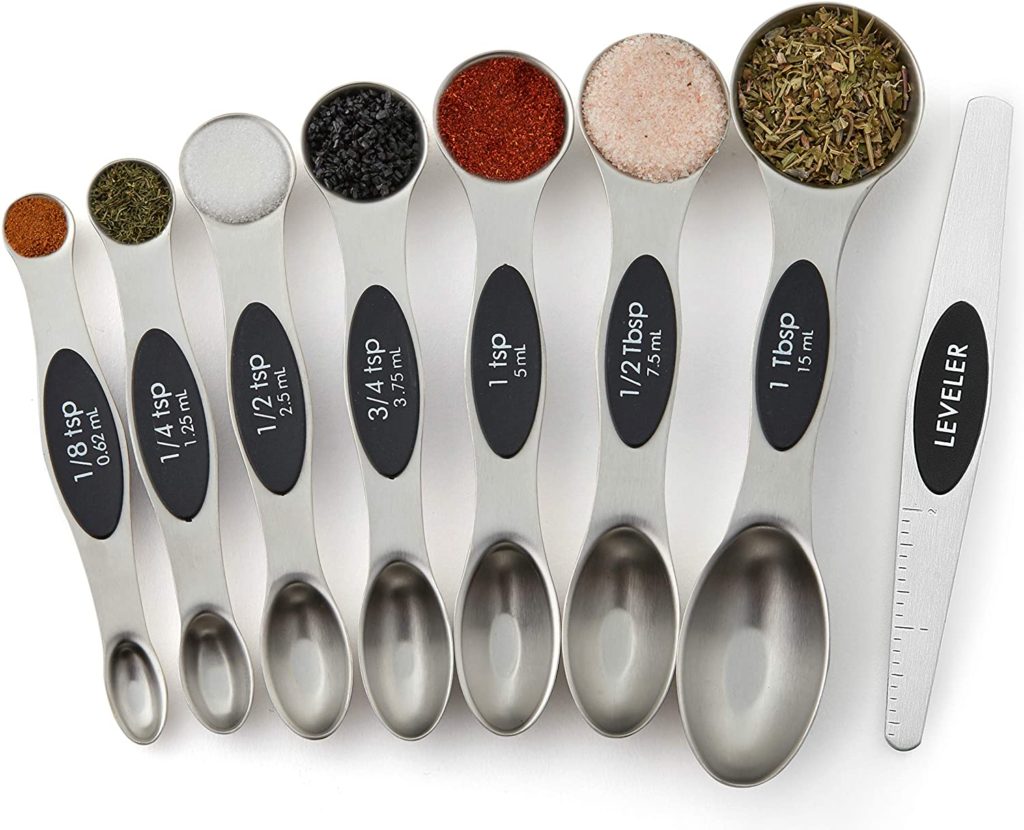
Measuring Spoons
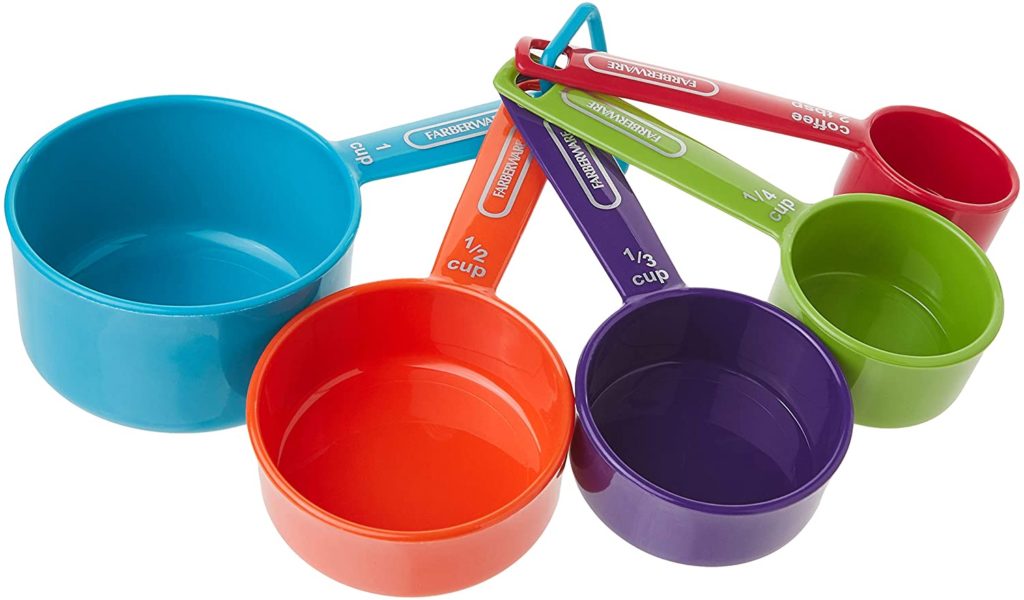
Measuring Cups
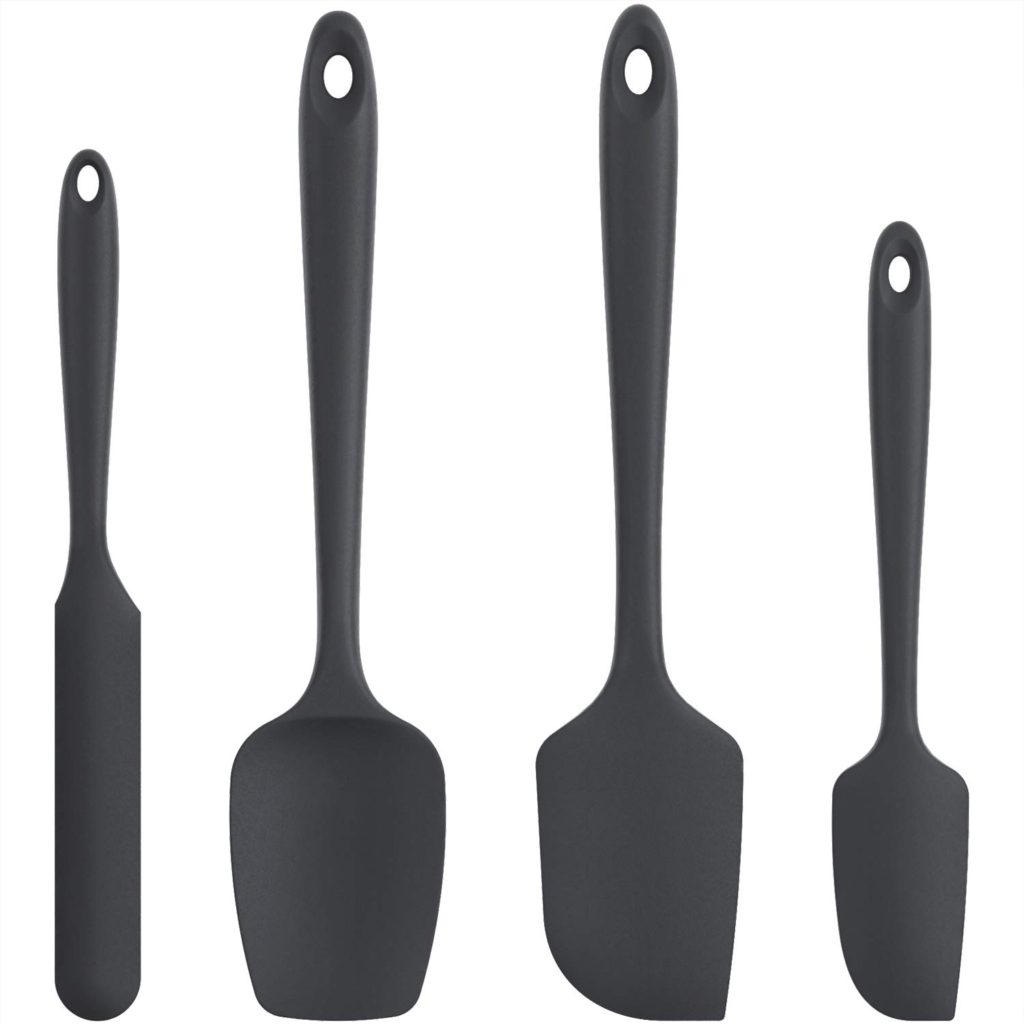

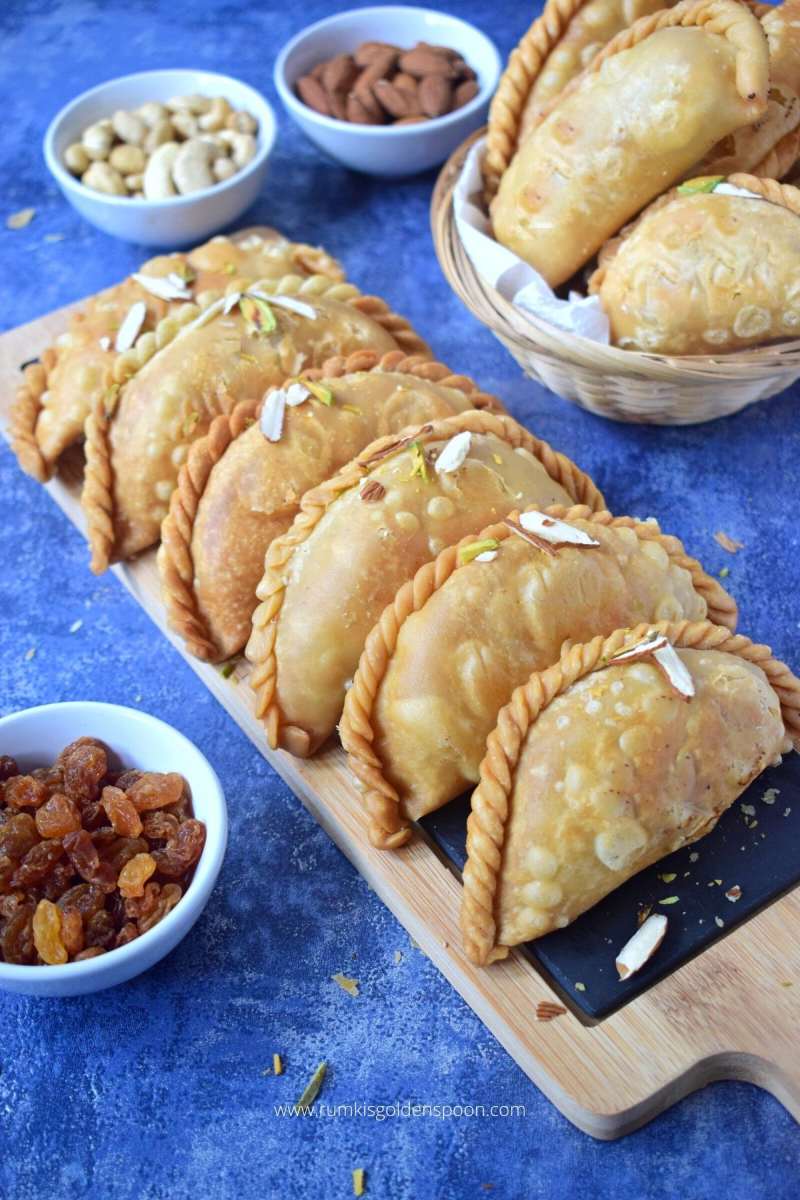
1 comment
[…] Gujiya Shankarpali Instant jalebi Atta ladoo Dahi vada Instant dhokla Baked mathri Masala makhana […]